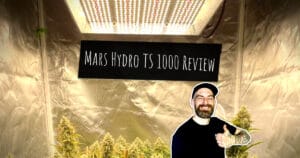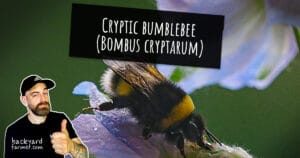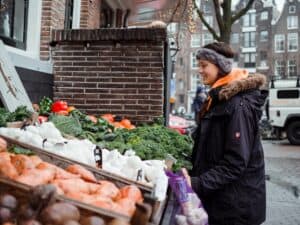Introduction: How to Grow Tomatoes Indoors
If you’re wondering how to grow tomatoes indoors using lights, this guide breaks it all down simply — from choosing the right setup to harvesting juicy homegrown fruits. Whether you’re short on outdoor space, eager to extend the growing season, or simply want more control over your plants, indoor tomato gardening is a rewarding and practical solution.
Why Learn How to Grow Tomatoes Indoors?
- Enjoy fresh tomatoes year-round – No need to wait for warm weather.
- Reduce pests and diseases – Keep your plants safe from common outdoor threats.
- Maximize small spaces – Perfect for apartments, small homes, or balconies.
- Control quality – Choose organic fertilizers and avoid chemical pesticides.
- Create the perfect climate – Grow tomatoes regardless of outdoor conditions.
Of course, growing tomatoes indoors comes with a few challenges, like pollination and lighting. But don’t worry! This guide walks you through how to grow tomatoes indoors successfully, covering the best varieties, proper lighting, and care techniques to maximize your harvest. With the right approach, even a small space can become a thriving tomato garden.
Continue your indoor vegetable growing journey
- Top 10 easy indoor vegetables to grow – A practical guide to beginner-friendly plants that thrive in indoor setups alongside your tomatoes
- Indoor vegetable garden design — aesthetics and functionality – Tips on how to lay out your indoor garden so that light, airflow, and plant spacing work beautifully together
- Best LED grow lights for tomatoes indoors – A dedicated look at lights that suit fruiting plants like tomatoes, with tested recommendations and performance notes
How to Succeed with Indoor Tomato Gardening
To grow healthy, productive tomato plants indoors, focus on these key factors:
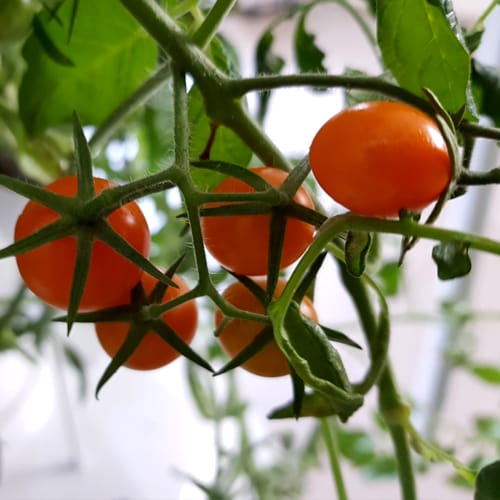
- Choose the right variety – Compact or dwarf varieties thrive indoors.
- Provide enough light – Tomatoes need 14–16 hours of full-spectrum light daily. Keep grow lights 6–12 inches above plants to prevent stretching.
- Water and feed consistently – Water when the top 1–2 inches of soil feel dry and use a balanced fertilizer.
- Pollinate by hand – Since there are no natural pollinators indoors, use a soft brush or electric toothbrush to transfer pollen.
- Monitor pests and diseases – Regularly check your plants and use organic pest control methods when needed.
What This Guide Covers
This guide covers everything you need to know, including:
- Choosing the best containers and soil for indoor growth.
- Understanding lighting and temperature requirements.
- Learning how to pollinate and prune for maximum yield.
- Preventing and treating common indoor plant issues.
Whether you’re growing cherry tomatoes indoors or looking for the best soil for indoor tomato plants, this guide will help you get started. With a little planning and effort, you’ll soon enjoy the unbeatable flavor of fresh tomatoes picked straight from your indoor garden. Let’s get started!
Exact Requirements for Growing Tomatoes Indoors
Growing tomatoes indoors successfully comes down to getting a few key details right. While tomato plants are fairly forgiving, providing clear, repeatable indoor growing conditions makes a noticeable difference to growth rate, flower set, and overall flavour — particularly when you’re learning how to grow tomatoes indoors with lights.
With that in mind, the guidelines below act as a reliable, no‑nonsense baseline for most indoor tomato plants, whether you’re growing cherry tomatoes indoors or compact bush varieties.
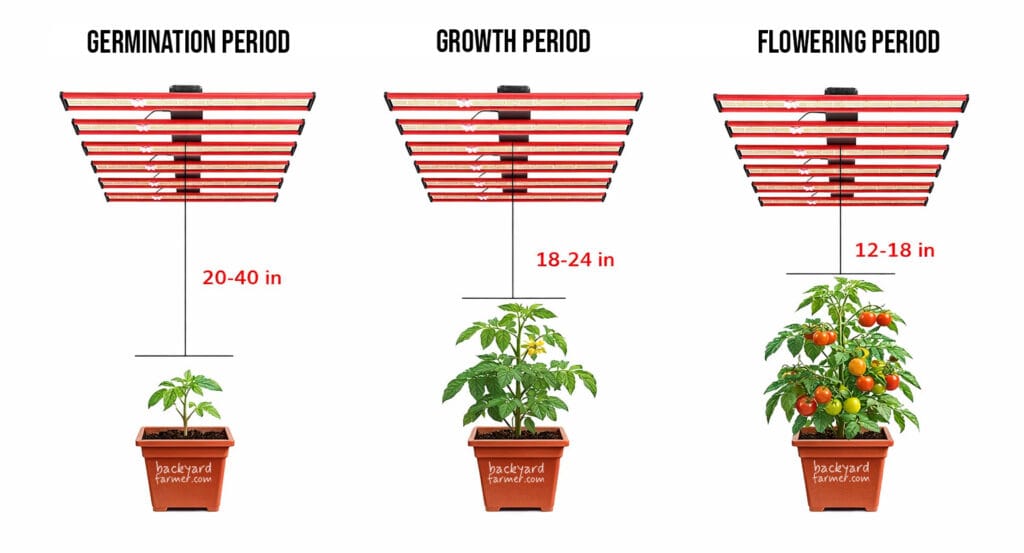
Indoor Tomato Temperature Requirements (Day & Night)
First of all, indoor tomato plants thrive on consistency. Although they can tolerate small fluctuations, ongoing temperature swings are one of the most common reasons tomatoes drop flowers, stretch, or produce weak growth indoors.
Ideal indoor tomato temperature range
- Daytime: 18–24°C (65–75°F)
- Night-time: 15–18°C (59–65°F)
Key points to remember
- If indoor temperatures regularly rise above 26°C (79°F), pollination rates often fall and fruit set can suffer.
- By contrast, temperatures below 12°C (54°F) slow growth and restrict nutrient uptake.
- Therefore, avoid placing indoor tomato plants near cold windows, draughts, or direct heat sources such as radiators.
Tomato Light Requirements Indoors (Light Hours & PPFD)
Above all else, light is the single most important factor when growing tomatoes indoors. Without adequate light intensity and duration, plants quickly become leggy, flowering slows down, and yields drop — even if watering and feeding are spot on.
Indoor tomato light hours
- 14–16 hours per day under full‑spectrum grow lights
- For best results, use a timer to keep lighting consistent from day to day
Recommended PPFD levels for indoor tomatoes
- Seedlings: 200–300 PPFD
- Vegetative growth: 400–600 PPFD
- Flowering & fruiting: 600–900 PPFD
Practical grow light tips
- Position LED grow lights 6–12 inches above the plant canopy
- Gradually increase light intensity as tomato plants mature
- Meanwhile, rotate pots weekly to ensure even light coverage across the foliage
Pot Size Requirements for Indoor Tomato Plants
Just as importantly, choosing the right pot size directly affects root development, nutrient uptake, and overall indoor tomato growth. In fact, undersized containers are one of the most common causes of stunted tomatoes when growing indoors.
Recommended pot sizes for indoor tomatoes
- Dwarf or micro varieties: 2–3 gallon (7–11 litres)
- Cherry tomatoes: 3–5 gallon (11–19 litres)
- Full‑size indeterminate tomatoes: 5–7 gallon (19–26 litres)
Potting tips for best results
- Always use containers with proper drainage holes
- Fabric pots or air pots improve oxygen flow to tomato roots
- However, avoid allowing plants to become root‑bound, as this often reduces flowering and fruit production
Indoor Tomato Watering & Feeding Schedule
When it comes to indoor tomato care, consistent watering matters far more than frequent watering. Tomato plants prefer even moisture, and overwatering remains one of the leading causes of yellow leaves, poor growth, and fungal problems indoors.
Indoor tomato watering guidelines
- Water when the top 2–3 cm (1 inch) of soil feels dry to the touch
- In most indoor setups, this usually means watering every 2–3 days, depending on temperature, pot size, and airflow
- Always water slowly, allowing excess moisture to drain freely from the bottom of the pot
Indoor tomato feeding schedule
- Seedlings: No fertiliser until the first true leaves appear
- Vegetative stage: Apply a balanced liquid fertiliser every 10–14 days
- Flowering & fruiting: Switch to a potassium‑rich tomato feed every 7–10 days to support fruit development
Optional supplements (only if needed)
- Epsom salt (magnesium): Once monthly if deficiency symptoms appear
- Calcium sources (eggshells or cal‑mag): Helpful for preventing blossom end rot on indoor tomatoes
Quick Reference: Indoor Tomato Growing Requirements
- Indoor tomato temperature: 18–24°C (day) / 15–18°C (night)
- Light hours: 14–16 hours daily under grow lights
- PPFD range: 400–900, depending on growth stage
- Pot size: 3–7 gallons, depending on tomato variety
- Watering frequency: Every 2–3 days (soil‑dependent)
Overall, these exact indoor tomato growing requirements provide a dependable foundation for healthy, productive plants. While you can fine‑tune conditions to suit your space, tomato variety, and lighting setup, staying close to these ranges will help you grow tomatoes indoors more reliably and with far better results.
Indoor Tomato Growth Timeline (Seed to Harvest)
Once your growing conditions are dialled in, it helps to know what to expect at each stage of growth. This timeline gives you a realistic overview of how long indoor tomatoes take to grow under lights, from sowing seed to picking ripe fruit. Times can vary slightly by variety, but the stages below apply to most indoor tomato plants.
| Growth Stage | Typical Timeframe | What’s Happening | What You Should Do |
|---|---|---|---|
| Germination | 5–10 days | Seeds sprout and first shoots appear | Keep soil warm (20–25°C), lightly moist, and under gentle light |
| Seedling stage | 1–3 weeks | First true leaves develop | Increase light intensity, avoid overwatering, no feeding yet |
| Vegetative growth | 3–5 weeks | Rapid leaf and stem growth | Pot up if needed, begin light feeding, provide support |
| Flowering | 5–7 weeks | Yellow flowers open | Maintain stable temperatures and hand‑pollinate indoors |
| Fruit set | 6–9 weeks | Small green tomatoes form | Switch to potassium‑rich feed, keep watering consistent |
| Ripening & harvest | 8–12+ weeks | Fruit colours and sweetens | Harvest regularly to encourage continued fruiting |
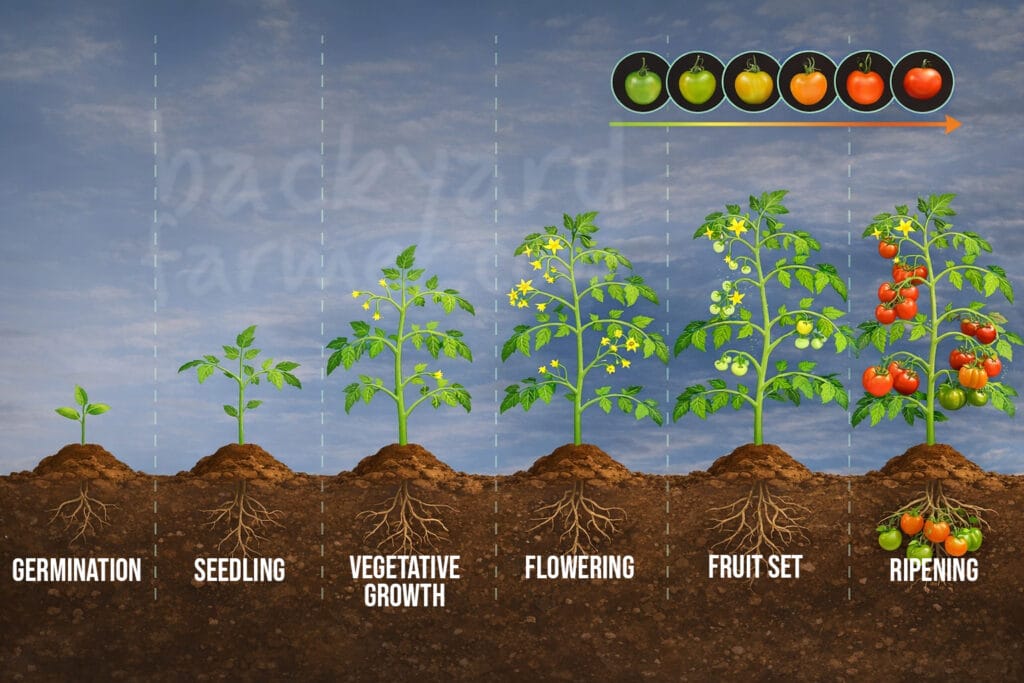
Good to know:
- Cherry tomatoes grown indoors often reach harvest faster than full‑size varieties.
- Cooler temperatures or low light will slow this timeline.
- Strong lighting and steady care usually mean earlier and heavier harvests.
This growth timeline sets clear expectations and helps you spot problems early — especially if plants stall, flower late, or fail to set fruit indoors.
Best Tomatoes for Growing Indoors
With so many tomato varieties available, it can be challenging to know where to start. Here is a list of compact tomato varieties perfect for container growing, especially if you are figuring out how to grow tomatoes indoors.

Compact Varieties for Containers
| Variety | Type | Growth Habit | Height (inches) | Notes |
|---|---|---|---|---|
| Tiny Temptations | Determinate | Very compact | 6-12 | Ideal for small spaces |
| Tumbling Tom | Indeterminate | Trailing | Variable | Great for hanging baskets |
| Summerlast | Indeterminate | Dwarf | 36-48 | Sturdy, requires less staking |
| Crimson Plum | Indeterminate | Compact | 24-36 | Blight-resistant, rich flavor, ideal for sauces |
Red Alert | Determinate | Bush | 12-18 | Early fruiting, no support needed, sweet flavor |
Best Cherry and Grape Tomatoes for Continuous Harvests
| Variety | Type | Growth Habit | Height (feet) | Notes |
|---|---|---|---|---|
| Alicante | Indeterminate | Vining | 5-6 | Medium-sized, round fruits with balanced flavor |
| Gardener’s Delight | Indeterminate | Vining | 6-8 | Sweet, cherry-sized fruits, prolific cropper |
| Shirley F1 | Indeterminate | Vining | 6-8 | High yields, disease-resistant, excellent flavor |
| Moneymaker | Indeterminate | Vining | 5-7 | Heavy crops, suitable for indoor and outdoor growing |
| StripSungold F1 | Indeterminate | Vining | 6-8 | Sweet, golden-orange cherry tomatoes, prolific producer |
Disease Resistant Tomato Varieties
| Variety | Type | Growth Habit | Height (feet) | Notes |
|---|---|---|---|---|
| Crimson Cherry F1 | Indeterminate | Vining | 6-8 | Blight-resistant cherry tomato, excellent sweetness and tang |
| Crimson Plum F1 | Determinate | Compact | 3-4 | Blight-resistant plum tomato, great for cooking and sauces |
| Rubylicious F1 | Indeterminate | Vining | 6-8 | Sweet and tangy cherry tomato with excellent blight tolerance |
| Black Moon F1 | Indeterminate | Vining | 6-8 | Bi-colored, rich flavor with strong disease resistance |
| Crimson Crush F1 | Indeterminate | Vining | 5-6 | Heavy-cropping round tomato, highly resistant to blight |
How to Grow Tomatoes Indoors: Step-by-Step Guide
Learning how to grow tomatoes indoors is easy with the right setup. Whether you’re growing cherry tomatoes indoors or cultivating full-sized varieties, these steps will help you create the perfect growing environment.

1: Choose the Right Tomato Variety
- Select compact or dwarf varieties that thrive indoors.
- Great options include Tiny Temptations, Red Alert, and Crimson Cherry F1.
- Determinate (bush) varieties are ideal for small spaces, while indeterminate (vining) varieties need staking and pruning.
- Cherry tomatoes are an excellent choice for continuous harvesting in compact areas.
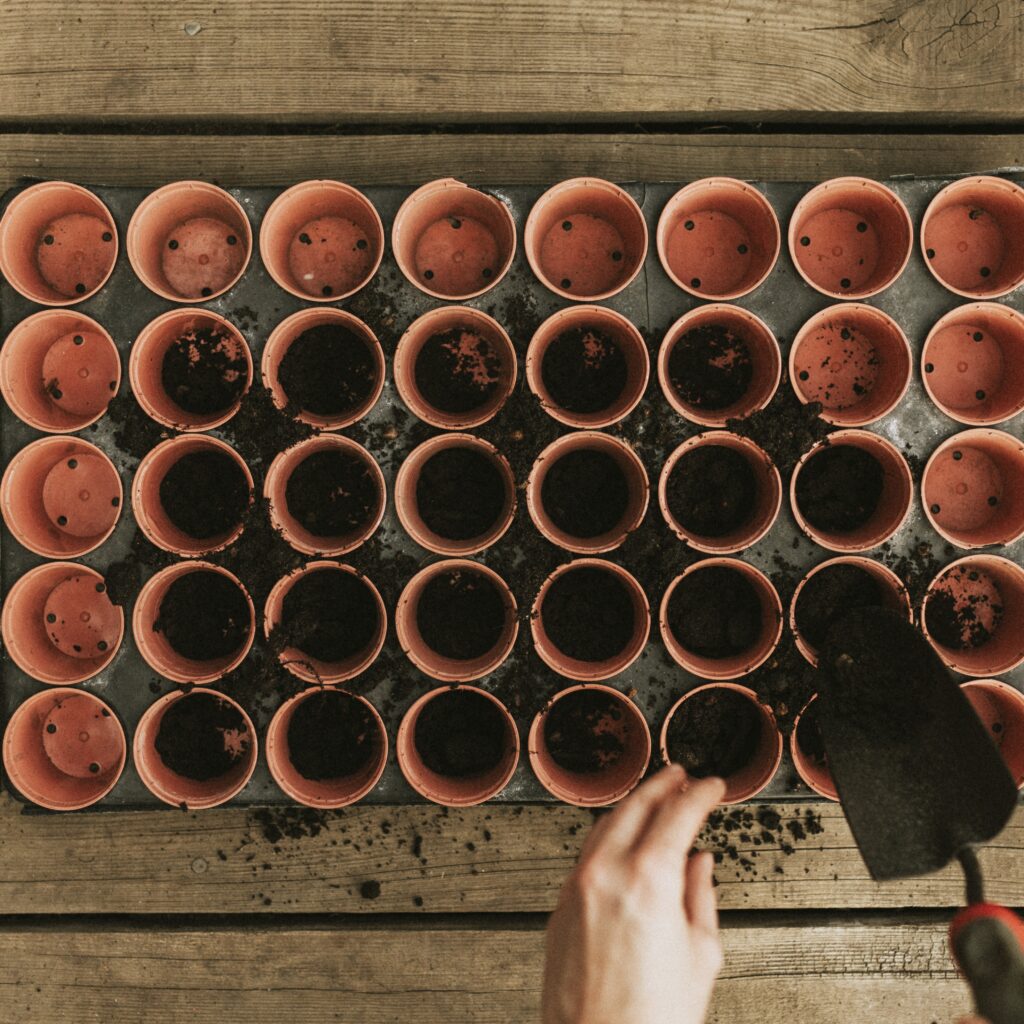
2: Prepare the Growing Setup
- Use containers with drainage holes—at least 2–3 gallon pots for cherry tomatoes and 5-gallon pots for larger varieties.
- Choose high-quality potting soil rich in organic matter. The best soil for indoor tomatoes includes compost and perlite for improved aeration.
- Place containers in a warm, bright spot or use grow lights to maintain consistent growth.
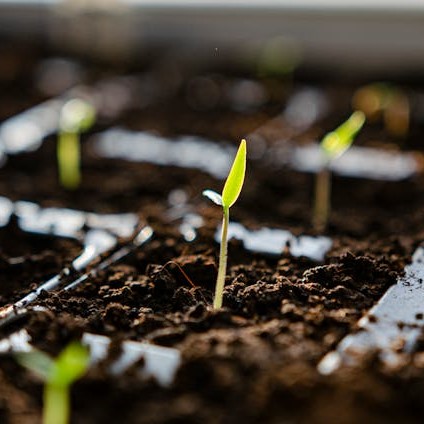
3: Germinate Your Tomato Seeds
- Pre-soak seeds for 12–24 hours before planting to speed up germination.
- Sow seeds ¼ inch deep in seed trays or small pots.
- Keep the soil moist but not waterlogged.
- Maintain a temperature of 20–25°C (68–77°F) for optimal sprouting.
- Cover with humidity domes or plastic wrap to retain moisture.
- Expect seedlings to emerge within 5–10 days.

4: Provide Proper Lighting & Heat
- Use full-spectrum LED grow lights like the Mars TSW2000 for 14–16 hours daily.
- Tomatoes need 2,000–5,000 lumens per square foot. Understanding tomato light requirements is crucial for healthy growth.
- Position grow lights 6–12 inches above seedlings to prevent legginess.
- Maintain 18–24°C (65–75°F) during the day, with nighttime temperatures between 15–18°C (59–65°F).
- Rotate plants regularly to ensure even light exposure.
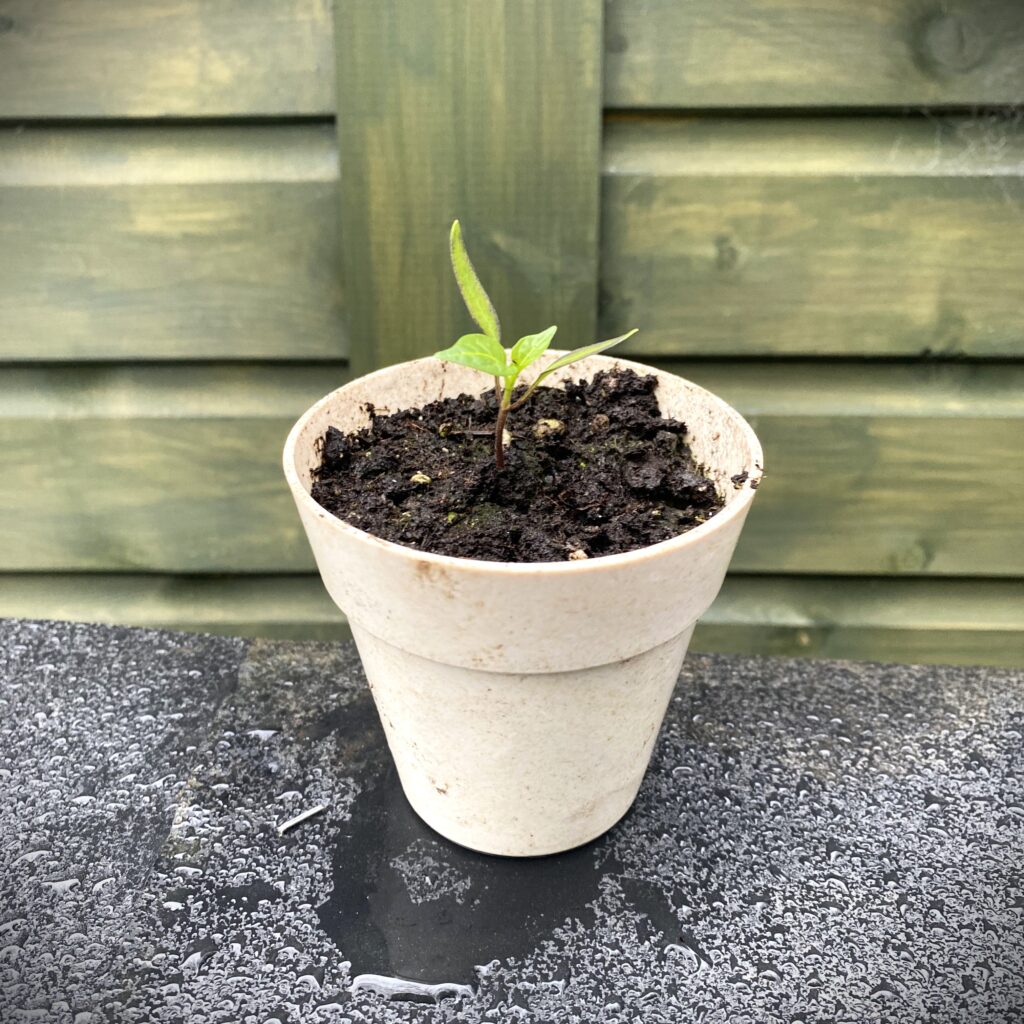
5: Transplant the Seedlings
- Once seedlings develop 3–4 true leaves, transplant them into larger pots.
- Bury part of the stem deeper to encourage strong root growth.
- Use a mix of compost and perlite to improve soil aeration.
- Water gently to minimize transplant shock.

6: Water & Feed Regularly
- Keep the soil moist but not soggy by watering every 2–3 days, adjusting based on moisture levels.
- Use a balanced liquid fertilizer every 2 weeks.
- Add 1 tablespoon of Epsom salt per gallon of water once a month to prevent magnesium deficiency.
- Once flowering starts, switch to a potassium-rich fertilizer to enhance fruit production.
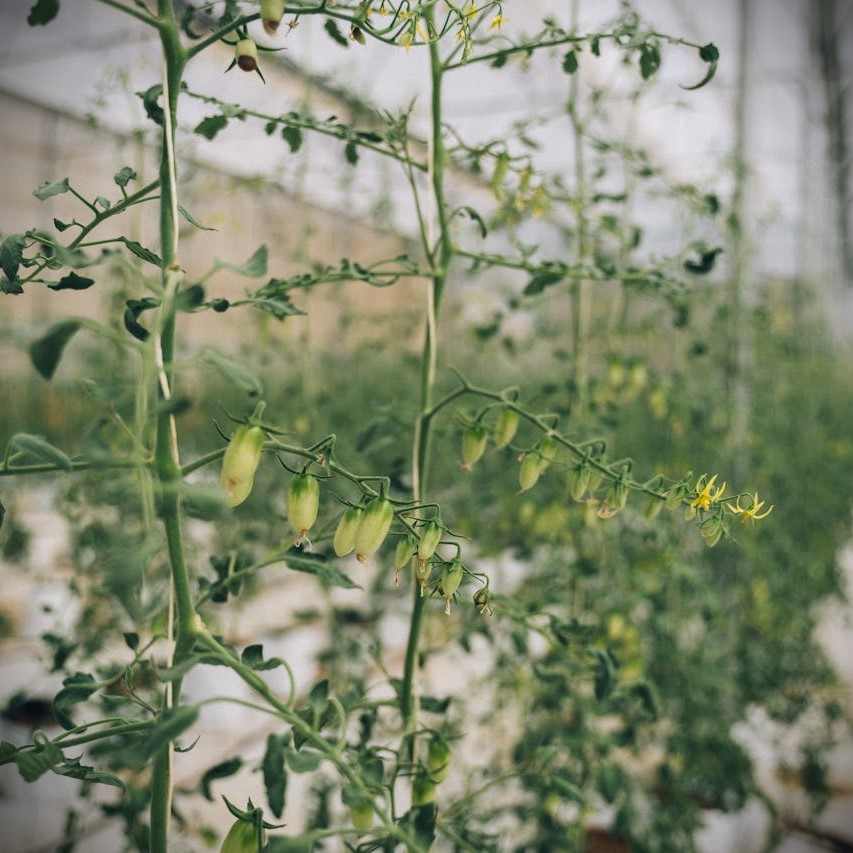
7: Support & Pollinate Indoor Tomato Plants
- Stake or cage taller varieties to provide proper support.
- Use small cages for determinate varieties and taller stakes for indeterminate types.
- Hand-pollinate by gently shaking flowers or using a soft brush to transfer pollen.
- Ensure good airflow to support healthy plant development.
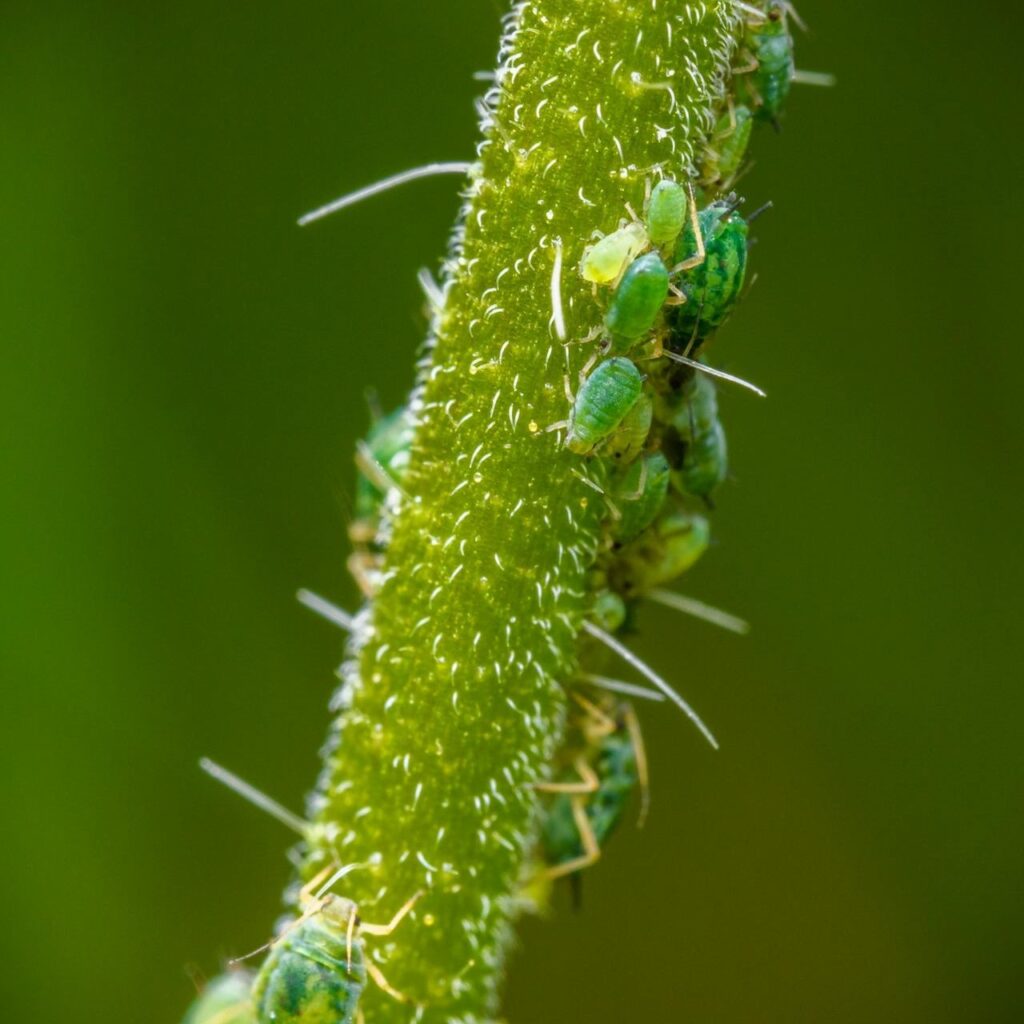
8: Indoor Tomato Plant Care: Managing Pests & Diseases
- Inspect plants regularly for pests like aphids and whiteflies.
- Apply neem oil or insecticidal soap at the first sign of infestation.
- Keep the growing area well-ventilated to prevent mold and fungal diseases.
- Always water at soil level to avoid wet leaves and fungal issues.

9: Harvest Your Tomatoes
- Tomatoes are ripe when they develop full color and feel slightly soft.
- Pick them regularly to encourage continuous fruiting.
- Fully ripe tomatoes should detach easily from the vine.
- Store at room temperature for optimal flavor—avoid refrigeration, as cold temperatures reduce sweetness and texture.
By following these steps, you’ll successfully learn how to grow tomatoes indoors and enjoy fresh, homegrown tomatoes all year long! Once you have harvested your tomatoes, you may want to peel them for sauces! Learn ‘How to Peel Tomatoes in 4 Easy Steps’ here.
Indoor Tomato Plant Care: Troubleshooting Common Growing Issues
Even when you know how to grow tomatoes indoors, challenges can still arise. This guide to indoor tomato plant care will help you identify and fix common problems before they affect your harvest.
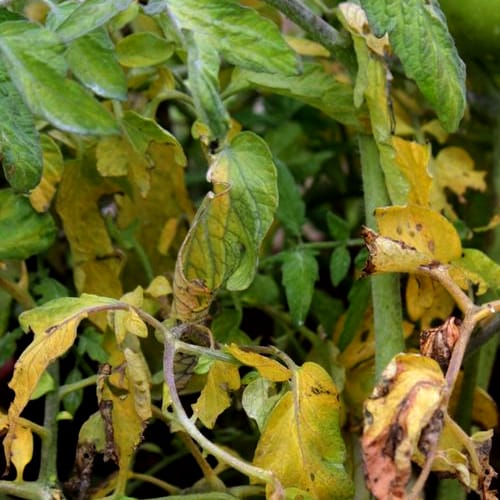
1. Why Are My Tomato Leaves Turning Yellow?
- Causes: Overwatering, nutrient deficiencies (especially nitrogen or magnesium), or poor drainage.
- Fix: Reduce watering and ensure your container has proper drainage. If nitrogen is lacking, apply a balanced fertilizer. To correct magnesium deficiency, dissolve 1 tablespoon of Epsom salt in a gallon of water and spray it on the leaves once a month. Yellowing leaves are one of the most common tomato plant diseases and should be treated early.

2. Leggy Seedlings (Weak and Spindly Growth)
- Causes: Insufficient light, high temperatures, or grow lights positioned too far away.
- Fix: Position full-spectrum grow lights 6–12 inches above seedlings and keep them on for 14–16 hours daily. Maintain a steady temperature between 18–24°C (65–75°F) to prevent stretching.
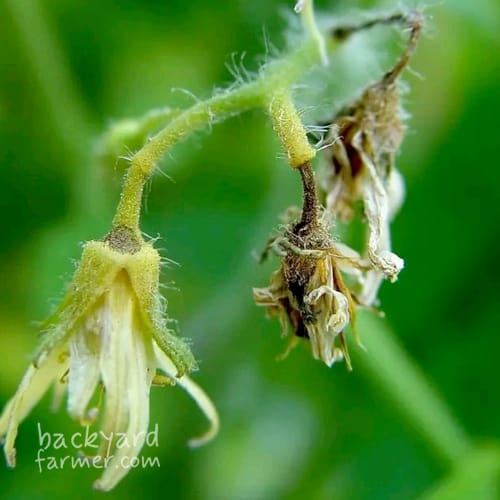
3. Why Are My Tomato Flowers Dropping? (Indoor Pollination Fixes)
- Causes: Poor pollination, temperature swings, or nutrient deficiencies.
- Fix: Hand-pollinate by gently shaking the flowers or using a soft brush or electric toothbrush to transfer pollen. Keep temperatures steady between 18–24°C (65–75°F) during the day and at least 15°C (59°F) at night.

4. Small or Tasteless Tomatoes
- Causes: Inconsistent watering, poor soil quality, or a lack of potassium or calcium.
- Fix: Water consistently to maintain even moisture levels. Use rich organic soil—the best soil for indoor tomatoes contains compost and perlite. Once fruiting begins, switch to a potassium-rich fertilizer. If calcium is lacking, mix in crushed eggshells or calcium nitrate to improve fruit quality.

5. Preventing Fungal Diseases in Indoor Tomato Plants
- Causes: Poor air circulation, high humidity, overwatering, or poor drainage.
- Fix: Increase airflow using a small oscillating fan. Lower humidity levels and let the soil dry slightly between waterings. Use a well-draining soil mix and slightly elevate pots to prevent water buildup.
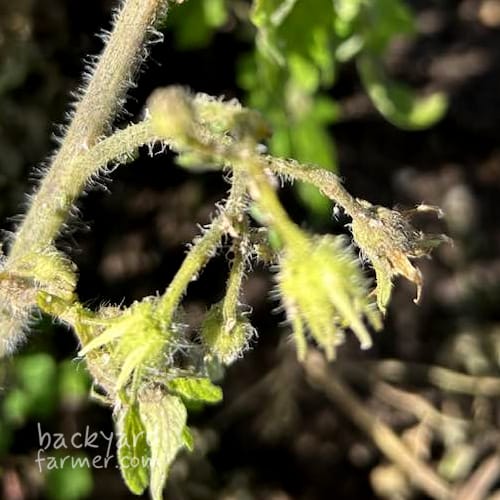
6. Preventing Pests on Tomato Plants (Aphids, Whiteflies, Spider Mites)
- Causes: Pests often enter on store-bought plants or through contaminated soil.
- Fix: Inspect plants regularly and treat infestations with neem oil or insecticidal soap. Always quarantine new plants for at least a week before placing them near your existing tomatoes.
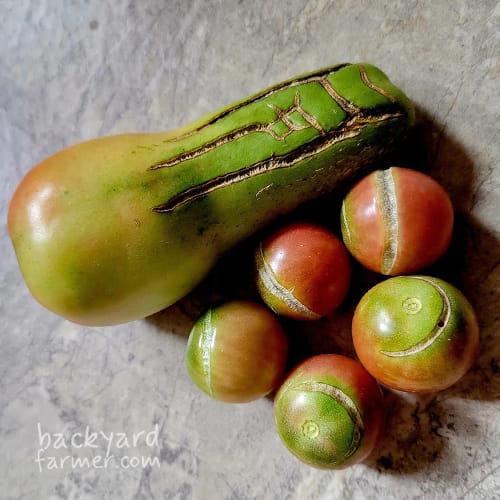
7. Why Are My Tomatoes Cracking?
- Causes: Uneven watering or sudden water absorption after a dry spell.
- Fix: Water consistently to prevent stress. Avoid sudden heavy watering after dry periods. Adding mulch helps retain soil moisture and prevent rapid water intake.

8. Tomato Plant Growth Problems: How to Fix Stunted Indoor Tomatoes
- Causes: Overcrowding, nutrient deficiencies, poor root development, or root-bound plants.
- Fix: Ensure plants have enough space to grow, fertilize regularly, and transplant to larger containers if needed. If roots are circling inside the pot, gently loosen the root ball before repotting.
By addressing these problems early, you’ll keep your indoor tomatoes healthy and productive. If you’re wondering how to grow tomatoes indoors successfully, solving these common issues will help ensure a thriving harvest!
Frequently Asked Questions (FAQ) on How to Grow Tomatoes Indoors
Yes! If you want to master how to grow tomatoes indoors, the right lighting, temperature, and care are essential. With the proper setup, you can enjoy fresh tomatoes year-round, whether you’re growing full-sized varieties or choosing to grow cherry tomatoes indoors for a continuous harvest. Full-spectrum grow lights and a stable environment ensure steady growth and fruit production.
Since there are no natural pollinators indoors, you’ll need to do it yourself. Gently shake the flowers or use a small paintbrush or an electric toothbrush to transfer pollen. This method mimics the vibration of bees and increases fruit production.
The best soil for indoor tomatoes is a high-quality potting mix with good drainage and organic compost. Avoid garden soil, as it compacts easily and harbors pests. Ensure the soil pH stays between 6.0–6.8 for optimal nutrient uptake. A mix containing compost, perlite, and coco coir works well for indoor growth.
Tomatoes need 14–16 hours of full-spectrum light per day for healthy growth. Without enough light, they can become leggy and produce fewer fruits. If you’re wondering how to grow tomatoes indoors with lights, use full-spectrum LED grow lights and position them 6–12 inches above the plants to prevent stretching.
For strong, healthy growth, maintain daytime temperatures between 18–24°C (65–75°F) and nighttime temperatures between 15–18°C (59–65°F).
It’s possible, but you’ll need a south-facing window that gets at least 6–8 hours of direct sunlight. However, during winter or on cloudy days, grow lights provide more reliable and consistent results.
Good airflow is key. Use a small oscillating fan to improve circulation, avoid overwatering, and choose a well-draining soil mix. Keeping humidity levels under control also helps prevent fungal growth.
It depends on the variety. Cherry tomatoes mature in about 8 weeks, while larger varieties take 10–12 weeks from germination to harvest.
Leggy seedlings usually mean they’re not getting enough light. Move them closer to a strong light source or use grow lights for 14–16 hours per day. Keep grow lights 6–12 inches above the plants to encourage sturdy growth.
Basil, chives, and marigolds are great companions because they help repel pests and improve growth. Avoid planting tomatoes near fennel or corn, as they compete for nutrients. Check out our Free Allotment planner for help figuring out the best companions for your veg!
Small or flavorless tomatoes are usually caused by inconsistent watering, poor soil quality, or nutrient deficiencies. Using the best soil for indoor tomatoes ensures proper nutrient uptake, improving both fruit size and flavor. Water consistently, enrich the soil with organic matter, and switch to a potassium- and calcium-rich fertilizer when fruiting begins.
Absolutely! Compact tomato varieties thrive in apartments. Just place them near a sunny window or under grow lights and ensure good ventilation for healthy plants.
With the right setup and care, growing tomatoes indoors is both rewarding and achievable. Whether you’re new to indoor gardening or an experienced grower, following these tips will help you enjoy a successful harvest. Let me know if you need any refinements!
Conclusion: How to Grow Tomatoes Indoors Successfully
If you’re wondering how to grow tomatoes indoors, this guide has covered everything from selecting the right variety to setting up proper lighting and providing essential care. Whether you choose to grow cherry tomatoes indoors or experiment with other varieties, your indoor garden can flourish with the right approach.
Key Takeaways:
- Choose the right variety – Compact, dwarf, and determinate (bush) varieties are best for indoor growing, as they require less space and minimal support.
- Provide adequate light – Understanding tomato light requirements is crucial. Tomatoes need 14–16 hours of full-spectrum light daily. Position grow lights 6–12 inches above the plants to prevent stretching and promote strong growth.
- Maintain consistent care – Water when the top 1–2 inches of soil feel dry, fertilize regularly, and ensure good airflow to prevent fungal issues. Using the best soil for indoor tomatoes supports nutrient absorption and encourages healthy root development.
- Manually pollinate flowers – Since there are no natural pollinators indoors, use a soft brush or electric toothbrush to transfer pollen between flowers and improve fruit production.
- Monitor for pests and diseases – Regularly inspect plants for aphids, whiteflies, and fungal infections. Treat early with neem oil or insecticidal soap to maintain plant health.
With patience and proper care, you’ll soon be harvesting delicious, homegrown tomatoes straight from your indoor garden. Don’t hesitate to experiment with different varieties and growing techniques to find what works best for your space and lifestyle.
If you’re interested in outdoor tomato cultivation as well, check out our guide on how to grow tomatoes in the UK for more tips on maximizing your harvest.
Start growing today and enjoy the unbeatable taste of fresh, flavorful tomatoes—any time of the year!


